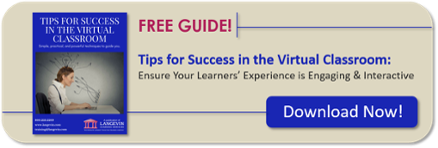
In a typical training course, learners spend significant amounts of time completing skill-based activities and exercises. During those exercises, or upon completion of them, each learner should receive feedback on their performance. In a traditional instructor-led course, the feedback process is fairly straight-forward. In virtual training, however, the process of giving and receiving quality feedback might pose a few challenges.
Having delivered virtual training for a few years, I’ve identified three challenges to providing feedback in the virtual classroom. Keep reading for some effective workarounds.
Challenge: Delivering personalized feedback
One-on-one or small group communication can be a bit more challenging in the virtual classroom. In most cases, the communication is openly broadcast to the entire group of learners. This could pose a challenge when attempting to deliver personalized feedback to an individual or small group.
Fortunately, most platforms have tools like private chat and breakout rooms. To keep the feedback personalized, have a private chat conversation with individual learners. Or, if you must give feedback to multiple groups, try using the breakout room function where only the members of each group are present.
As another option, divide the whiteboard into sections for each small group, or give multiple chat pods a try. I find these techniques also work well when you want your learners to deliver constructive feedback to each other.
Challenge: Encouraging trainees to provide constructive feedback
In both the traditional and virtual classroom setting, the most logical person to deliver feedback is the instructor. While this feedback approach does indeed work, it’s also a good idea to have variety. One option involves the learners giving feedback to each other—peer-to-peer feedback.
As with any training activity, this peer feedback approach must be set up and positioned the right way to be effective. In the virtual environment, the learners may be a bit shy because they’ve never seen or met their peers on the other end of the audio line. Or, some learners may feel they don’t have the appropriate skillset to give quality feedback.
Thankfully, there are workarounds to these issues. As virtual trainers, we should always be building rapport with our learners, both early on and continuously. The incorporation of icebreakers within your virtual course is a good way to do this. An icebreaker allows learners to get more comfortable with each other, increasing their comfort level delivering peer-to-peer feedback.
To remedy the perception of not having the appropriate skillset, always provide your learners with a performance checklist before they are tasked with offering feedback to their peers. This checklist can be part of their electronic manual or downloaded via the file share tool which is typically available on most virtual platforms. A well-designed checklist should provide a specific list of things to do, as well as a list of things to avoid, when delivering effective feedback.
Lastly, you should encourage peer feedback in a group setting within the virtual classroom. Facilitating the peer-to-peer feedback in this manner allows the trainer to oversee the process and provide additional feedback if necessary.
Challenge: Delivering carefully planned feedback
The way in which feedback is delivered in the virtual classroom requires more planning compared to the traditional classroom. The approach depends largely on both your timing constraints and the tools that will be used.
To address this particular challenge, you need to be proactive about how the feedback will be delivered, consider what tools will be required, and prepare effective supplemental materials well ahead of time (if they will be used).
Let’s say you are using a whiteboard for feedback purposes, and that whiteboard will be divided into sections. It’s a good best practice to prepare a slide beforehand so it can be displayed on the whiteboard. Or, if you plan to use multiple chat pods for peer feedback, it’s helpful to create a separate layout ahead of time that contains the number of chat pods required. Likewise, if a performance checklist is required for feedback purposes, it needs to be prepared in advance and included in the participant materials or loaded into a file share pod so it can be distributed to the learners when needed.
Time constraints in the virtual classroom often limit the spontaneous feedback that occurs more easily in the traditional classroom. To help with this, always provide a list of specific questions or criteria so the people providing feedback know exactly what they should be assessing. This list should be prepared in advance, complete with clear instructions and time limits given for each feedback opportunity.
Despite these few challenges, it is indeed possible to give and receive quality feedback in the virtual classroom. Just be sure to account for a few considerations like careful planning and maximizing the use of the tools within your virtual platform. When these things are considered, the feedback approach will be successful.
What challenges have you faced when providing feedback in the virtual classroom? What have you done to overcome those challenges?
Take your virtual classroom courses to the next level with the Maximizing Engagement in the Virtual Classroom workshop. Learn how to leverage the tools in your virtual platform to create powerful, interactive, and engaging virtual learning experiences.
Note: This post is part of a workshop intersession activity. As such, it is monitored in a slightly different manner than the other blog posts on our website. If you are not a participant in the applicable workshop, but have a question you would like answered, please feel free to contact us.



289 Responses to “Overcoming 3 Challenges to Providing Feedback in the Virtual Classroom”
I loved the idea of providing a performance checklist to help learners offer feedback to their peers.
I also liked the suggestions for using the whiteboard effectively.
We used to incorporate peer-to-peer feedback in our classroom training, but I thought it more difficult to do it in a virtual environment. This article gave me an important tip: to provide a checklist for peer-to-peer feedback to learners. I will definitely include that tool in my next trainings! Thanks!
Love the suggestions and examples in this post. Underlines for me the importance of feedback in virtual classrooms, the same as in traditional ones. I will be adding time in my planning, designing and developing VT to include methods for personalized feedback. Thank you for the amazing tips!
Given that I mostly do skill-based training, receiving proper feedback from the learners is crucial. As an instructor I need reassurance that the learners are understanding the material and are able to perform on the job once training is complete.
Great read!! Feedback is so important for continuous improvement. Loved the creative solutions that help to adapt to the new virtual training world. These guidelines with definitely aid in the transition from in-person to online. Thanks.
Feedback is absolutely essential in closing the learning loop. It can be challenging to ensure you have meaningful encounter from all parties. When delivering in a virtual classroom you will have to design your feedback or facilitate the interaction using various techniques. Those listed in the blog are a great start and I feel that I will build upon these foundations to meet the needs of attendees in future sessions. Thank you.
Great suggestions. I was part of a Toastmasters International group for a while and evaluation by peers was an important part. We had checklists to help us evaluate other participants’ speeches and then we had to present that information.
Excellent blog! I found it very helpful, especially being new to the world of design. Having more options to effectively deliver feedback is extremely valuable.
This article definitely has good points about feedback. I like the idea of peer-to-peer as that interaction is necessary in the virtual classroom.
I love that this article identifies 3 common challenges to providing feedback and provides creative solutions that incorporate active tools (chat, breakout rooms) and interaction among participants. It highlights that with careful planning, providing a checklist and simple activities such as an icebreaker to build rapport, peer-to-peer feedback can be successful. I will definitely include the suggested options in my training moving forward.